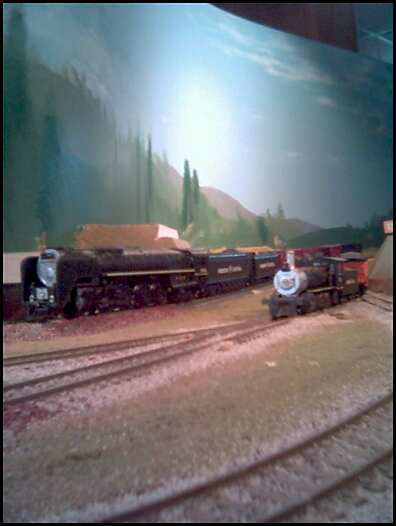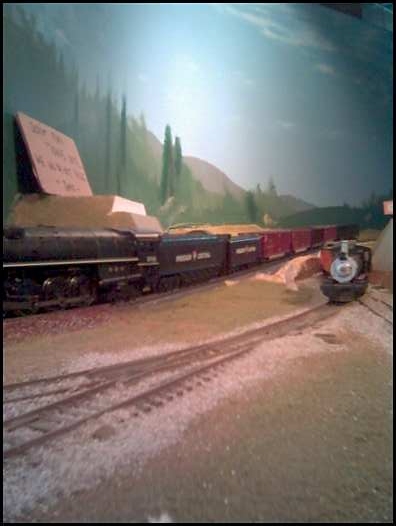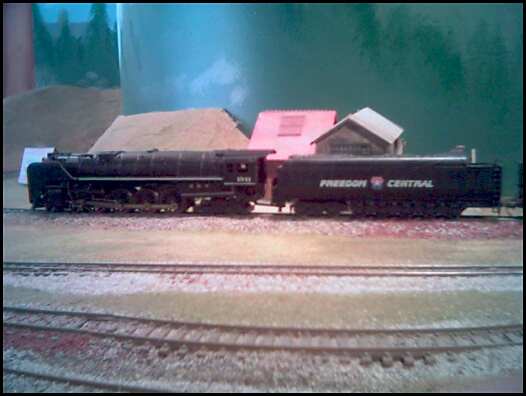




Not long after I hired on with the Arcade & Attica Railroad, things began to change. First, the local supermarket chain "Tops" contracted to have a Large Scale (colloquially known as "G" Scale) railroad installed that ran on a very large oval above the cash registers. The internet was coming into its own; rather than the services that offered it, AOL, CompuServe, etc, people were looking to the internet as a destination itself. Finally, for christmas that year I ended up with a large scale 4-6-2 pacific type steam locomotive, which got me hard core back into model railroading as well.
Mid-1999, I learned of the existance of a train shop in the East Aurora, NY area. For those who think they recognize East Aurora, you probably do. East Aurora was once headquarters for the massive Fisher-Price toy company. I believe the FP Museum still exists there to this day. After checking out the shop once or twice, I became friends with the owner, John Brahnaey himself a fan of the Arcade & Attica having riden it himself many times in his life. After a few months, he began trying to assemble a model railroad club. After a few meetings, John ended up moving his shop to
After purchasing the engine and tender from the local train shop in Arcade, I had Ricky Rupp of Modern Rails do up the decals and apply them for me after I got modifications and paintwork complete. Modern Rails did all the original artwork and decals for the Freedom Central Railway and I wanted to give him the business as he was just getting into the smaller scales at that time. After the engine and tenders were complete, I took them to visit their little cousin. Before I moved to Pennsylvania, I worked for the real Arcade & Attica Railroad. In late-2002/early-2003, I was part of a group that was converting the second exhibit room at the Arcade Station into a full-size layout room. We designed a double-loop HO scale model railroad that covered the Arcade Junction interchange with Conrail, the old Buffalo & Susquehanna line between the Junction and the Arcade Shops/yard complex. The line then went through the Arcade Station, across Cattaraugus Creek, and into the Curriers Station. From there the track disappeared into the trees, only to reappear near the Beaver Meadows Bridge. This little disappearing act took the train beneath and behind the "climbing" portion of the loop. After crossing the bridge, the train was almost at its top-level height as it pulled into the Reisdorf Bros. Feed Mill. Just like the real train, the model pulled into the mill's unloading bay. Only now it continued, hidden from view, to reappear a couple feet later as it approached the Varysburg Depot. There it would trundle past the station while a non-functional RDC, painted in the A&A's Passenger scheme, waited in the siding for the freight to pass. After leaving the station, the train would roll through some trees before appearing outside Attica State Prison. It would then enter the prison just like the real one did until the washout in 1957 when the prison switched from coal to oil for heating. The train would then appear on the other side of the prison and enter the Attica interchange with the Erie Railroad. Both the interchanges were linked with an isolated loop which ran a couple Conrail road-switchers with a local freight train. The A&A train then dissapeared and reappeared a few moments later back at the Arcade Juntion interchange to make the trip all over again.



In the first image above, Freedom Central No.1941 thunders downgrade through Arcade Junction with a short train of coal hoppers as Arcade & Attica excursion train Extra 18a rolls into the Interchange. No.1941 is on a test run after some rehab work at the Arcade Union Backshop. The loaded coal hoppers provide a simulated excursion train while not endangering any of the coporate varnish. Though this shot is for me, it demonstrates how the Conrail freight would have rolled through the scene once the layout had been completed.
In the second picture No.1941 continues her test run past the A&A excursion train. The cardboard sign in the background? Basically a smart comment about the first bridge to nowhere, that it would represent the overpass at the Arcade Junction. As you can see we really tried to create a layout which was both functional and also realistic to the operational railroad.
Here No.1941 speeds past some buildings representing the outbuildings of the Blue Seal Feedmill. The tracks in the foreground are the two runaround interchange tracks and just at the bottom left corner is the lead to the feedmill tracks. Once complete, the A&A freight would have trundled out of one of the feedmill's service bays as it began its loop around the layout; passing left to right in this picture.
In the first image above, Freedom Central No.1941 thunders downgrade through Arcade Junction with a short train of coal hoppers as Arcade & Attica excursion train Extra 18a rolls into the Interchange. No.1941 is on a test run after some rehab work at the Arcade Union Backshop. The loaded coal hoppers provide a simulated excursion train while not endangering any of the coporate varnish. Though this shot is for me, it demonstrates how the Conrail freight would have rolled through the scene once the layout had been completed.
In the second picture No.1941 continues her test run past the A&A excursion train. The cardboard sign in the background? Basically a smart comment about the first bridge to nowhere, that it would represent the overpass at the Arcade Junction. As you can see we really tried to create a layout which was both functional and also realistic to the operational railroad.
Here No.1941 speeds past some buildings representing the outbuildings of the Blue Seal Feedmill. The tracks in the foreground are the two runaround interchange tracks and just at the bottom left corner is the lead to the feedmill tracks. Once complete, the A&A freight would have trundled out of one of the feedmill's service bays as it began its loop around the layout; passing left to right in this picture.


